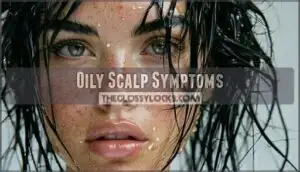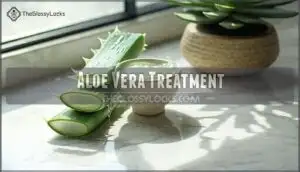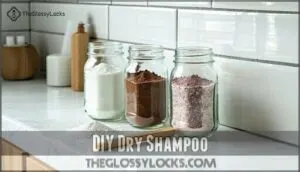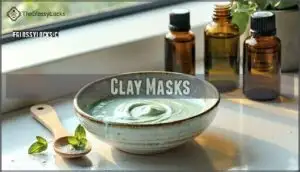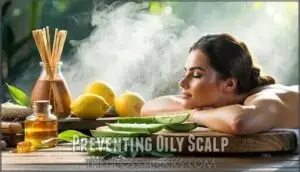This site is supported by our readers. We may earn a commission, at no cost to you, if you purchase through links.

Apple cider vinegar rinses balance pH levels, while tea tree oil fights excess sebum production. Clay masks absorb oil buildup, and aloe vera soothes inflammation without over-drying.
The key isn’t stripping all oils—that backfires by triggering more production. Instead, gentle cleansing with baking soda scrubs or lemon juice astringents helps regulate natural oil levels.
Regular scalp massages boost circulation, and witch hazel acts as a natural toner. These remedies address root causes like hormonal imbalances and product buildup, creating lasting results that keep your hair fresh between washes while restoring your scalp’s natural equilibrium.
Table Of Contents
- Key Takeaways
- Causes of Oily Scalp
- Oily Scalp Symptoms
- Natural Remedies
- Home Treatment Tips
- Preventing Oily Scalp
- Frequently Asked Questions (FAQs)
- Are there home remedies for oily scalp & greasy hair?
- How do I manage an oily scalp?
- How to get rid of oily scalp naturally?
- How to get rid of oily hair?
- How do I handle an oily scalp like a pro?
- Do you have an oily scalp?
- How do I stop my scalp from being so oily?
- Is oiling good for an oily scalp?
- How often should hairbrushes be cleaned for oily scalp?
- Is swimming in chlorinated pools safe for oily scalp?
- Conclusion
Key Takeaways
- Balance is key — Don’t strip all oils from your scalp, since this triggers overproduction. Use gentle cleansing methods, like diluted apple cider vinegar or aloe vera, to regulate natural oil levels without causing rebound oiliness.
- Kitchen ingredients work best — Apple cider vinegar rinses balance pH, tea tree oil fights excess sebum, baking soda provides gentle exfoliation, and clay masks absorb buildup more effectively than expensive commercial products.
- Address root causes, not just symptoms — Target hormonal imbalances through stress management, improve your diet by reducing sugar intake, and maintain proper washing frequency (every 2-3 days) to prevent your scalp from overcompensating.
- Consistency beats intensity — Choose 2-3 natural remedies that fit your routine and stick with them for several weeks. Your scalp needs time to rebalance, so patience and regular application of gentle treatments yield better results than harsh, sporadic interventions.
Causes of Oily Scalp
Understanding what triggers your oily scalp is the first step toward fixing it naturally.
Your scalp’s oil production can go into overdrive due to internal factors like hormones and genetics, or external culprits like harsh products and environmental pollutants.
Your scalp’s oil glands can shift into overdrive from hormones, genetics, harsh products, or pollution.
Sebum Overproduction
Your sebaceous glands naturally produce sebum to protect and moisturize your scalp, but sometimes they go into overdrive.
When androgen hormone influence increases sebaceous gland activity, your scalp oil production ramps up substantially.
This genetic predisposition affects sebum composition and disrupts your scalp microbiome balance.
Oily scalp treatment starts with understanding that natural remedies and home remedies can help regulate this overactive sebum production effectively, which is key to maintaining a healthy scalp through natural remedies.
Harsh Shampoos
Ironically, using harsh shampoos can make your oily scalp worse.
Stripping your scalp with harsh shampoos only makes it fight back by producing even more oil.
Sulfate-heavy formulas strip your scalp’s natural oils, triggering overproduction as your skin fights back. This creates a vicious cycle where frequent washing with aggressive cleansers actually increases oiliness.
Choose sulfate alternatives with balanced pH levels to prevent ingredient sensitivity and damage prevention. Adjust your shampoo frequency based on your scalp’s response—sometimes less is more for effective oily scalp treatment and proper scalp care to achieve a balanced and healthy scalp through proper scalp care.
Stress and Hormonal Imbalances
Your body’s response to stress throws your hormones into overdrive, particularly cortisol levels and testosterone, which directly boost sebum production.
During puberty changes and menopause effects, hormonal imbalances trigger your sebaceous glands to work overtime. These endocrine disruptors don’t just affect your mood—they ramp up hair oil production substantially.
Stress reduction techniques can help rebalance your system naturally. Consider that frequent hair washing can exacerbate the issue, and addressing hormonal imbalances and stress reduction can be key to managing sebum production.
Genetics and Diet
Your genetic makeup plays a significant role in determining oily scalp tendencies, with some people inheriting overactive sebaceous glands from their parents.
Diet also impacts sebum production through hormonal changes triggered by certain foods.
Here are three key factors affecting your scalp:
- Genetic Predisposition – Inherited traits influence how much oil your scalp naturally produces
- Sugar Consumption – High-sugar foods can spike insulin levels, increasing sebum production
- Processed Foods – These create nutrient deficiencies that disrupt healthy oil regulation
External Factors
While genetics and diet set the stage for oily scalp issues, external factors like Product Buildup from styling products create greasy layers that trap dirt.
Environmental Pollution clogs pores, while poor Headwear Hygiene and improper Washing Frequency worsen conditions.
These external triggers demand targeted home remedies for effective oily scalp treatment and ideal scalp health.
| External Factor | Impact on Scalp | Natural Solution |
|---|---|---|
| Product Buildup | Clogs pores, traps oils | Apple cider vinegar rinse |
| Environmental Pollution | Accumulates dirt, toxins | Clay mask detox treatment |
| Poor Headwear Hygiene | Breeds bacteria, oils | Regular washing, breathable fabrics |
| Improper Styling Practices | Heat damage, excess sebum | Air drying, minimal products |
Oily Scalp Symptoms
Recognizing the signs of an oily scalp helps you choose the right treatment approach.
You’ll notice your hair feels greasy within a day or two after washing, often accompanied by visible flakes, increased shedding, or small bumps along your hairline, which can guide you to the appropriate treatment approach.
Greasy Hair
Greasy hair hits you like a bad hair day that won’t quit—strands clump together, appearing wet even when dry.
Product buildup from styling treatments combines with irregular washing frequency to create this slick mess.
Your hairstyle impact matters too; tight ponytails spread oils faster down hair shafts.
Poor headwear hygiene and environmental exposure to pollution worsen the problem, making home remedies essential for restoring scalp health and addressing the issue of greasy hair.
Dandruff and Itchiness
Your oily scalp creates the perfect breeding ground for Malassezia growth, a yeast that feeds on excess oils and triggers dandruff formation.
This scalp inflammation leads to persistent itching and flaking that won’t quit.
Irritant contact from harsh products can worsen underlying conditions, making your scalp feel like it’s staging a rebellion.
Natural remedies and gentle oily scalp treatment options can calm this inflammatory response effectively.
Hair Loss
Unfortunately, excessive sebum production doesn’t just make your hair look greasy—it can actually trigger hair fall too.
When oil clogs your hair follicles, it creates an environment where hair growth slows down and existing strands become weaker.
This genetic predisposition to oily scalp treatment requires targeted home remedies focusing on scalp health.
Natural remedies like gentle cleansing and proper circulation can help restore normal hair growth patterns.
Acne and Whiteheads
When excess sebum mixes with dead skin cells and bacteria, you’ll notice small bumps and whiteheads sprouting across your scalp like unwelcome guests.
These scalp acne breakouts stem from pore clogging and bacterial infections that thrive in oily environments.
The combination of sebum overproduction and scalp inflammation creates perfect conditions for whitehead formation, often accompanied by dandruff and itchy scalp sensations.
Natural Remedies
When your scalp produces too much oil, you don’t need expensive treatments to find relief.
These natural remedies work by targeting the root causes of excess sebum production, helping restore balance to your scalp without harsh chemicals, which is a key factor in finding relief.
Aloe Vera Treatment
Aloe vera transforms your oily scalp treatment routine with its natural cleansing and balancing properties. This miracle plant contains enzymes that gently remove excess sebum while delivering essential moisture to your hair follicles.
You can also find aloe vera products for convenient use.
- Fresh aloe gel application: Extract gel directly from the plant for maximum potency and effectiveness
- Scalp massage technique: Work the gel into your roots using circular motions for 5-10 minutes
- Leave-in treatment: Allow aloe vera to penetrate for 30 minutes before rinsing with cool water
- Weekly routine: Apply this natural remedy 2-3 times per week for ideal oil control results
- Combination recipes: Mix aloe with lemon juice or tea tree oil for enhanced cleansing benefits
Apple Cider Vinegar Rinse
Apple cider vinegar works like nature’s reset button for your oily scalp treatment.
Mix one part ACV with three parts water for proper ACV dilution.
This home remedy balances scalp pH while boosting hair shine through effective residue removal.
You can also explore ACV products for specialized treatments.
Use hair rinses twice weekly—more frequent rinse frequency can irritate sensitive skin and disrupt your scalp’s natural protective barrier.
Coconut Oil Deep Conditioning
While apple cider vinegar works wonders for pH balance, coconut oil deep conditioning offers another powerful solution for oily scalp management.
This versatile hair oil penetrates your hair shaft, strengthening strands while regulating scalp health.
Unlike heavy products that worsen oiliness, coconut oil’s medium-chain fatty acids provide targeted nourishment.
Coconut oil also helps in reducing hair protein loss, which is essential for healthy hair.
Here’s your coconut oil hair conditioning routine:
- Warm slightly – Heat coconut oil between palms for easier application and better absorption
- Focus on mid-lengths – Apply primarily to hair strands, avoiding direct scalp contact to prevent excess oiliness
- Leave for 30 minutes – Cover with shower cap, allowing deep penetration without overwhelming your scalp
- Rinse thoroughly – Use gentle shampoo to remove all residue, leaving hair soft and manageable
This hair mask approach helps maintain moisture balance while supporting your scalp’s natural microbiome.
Tea Tree Oil Benefits
Tea tree oil packs antimicrobial properties that tackle scalp infections head-on.
This natural powerhouse reduces inflammation while providing effective dandruff control through its antifungal action.
When you add a few drops to your shampoo, it balances oil production without over-drying.
Clinical studies show 5% tea tree oil reduces dandruff by 41% in four weeks, supporting healthier hair growth conditions.
For daily use, consider mixing it with shampoo to leverage its anti-fungal properties.
Scalp Massages
Gentle massage techniques release your scalp’s natural balance by boosting circulation and distributing oils evenly.
Use fingertips in small circles for five minutes, three times weekly. This simple ritual helps regulate oil production while promoting scalp health.
Scalp massages may also help with relaxation and stress reduction. Choose lightweight oils sparingly or massage dry for effective scalp oil control without overwhelming your natural remedies routine.
Home Treatment Tips
You can tackle oily scalp issues right from your bathroom with simple ingredients you probably already have at home.
These DIY treatments work by absorbing excess oil, balancing your scalp’s pH, and gently removing buildup without harsh chemicals, which helps to address oily scalp issues effectively.
DIY Dry Shampoo
Between natural treatments and store-bought options, creating your own dry shampoo gives you complete control over DIY ingredients and scent customization.
This home remedy for oily scalp costs pennies compared to commercial versions, plus you know exactly what’s touching your hair.
Simple DIY dry shampoo recipes:
- Basic blend: Mix 2 tablespoons cornstarch with 1 tablespoon baking soda for instant oil absorption
- Brunette formula: Add 1 teaspoon cocoa powder to match darker hair tones perfectly
- Aromatherapy version: Include 3 drops lavender oil for relaxing scent customization and stress relief
Store your mixture in small mason jars or repurposed spice containers for easy application methods.
Sprinkle onto roots, massage gently, then brush through for texture variations that refresh second-day hair.
Baking Soda Exfoliator
Baking soda’s gritty texture makes it a powerful scalp exfoliation tool for tackling stubborn buildup.
Mix one part baking soda with two parts water, creating a paste for your DIY hair mask.
Massage gently into your oily scalp, focusing on problem areas, and let it sit for ten minutes before you rinse thoroughly—leftover residue can cause irritation.
Those with scalp sensitivity should test first.
Lemon Juice Astringent
Lemon juice acts as a powerful astringent for oily scalp treatment, naturally controlling excess sebum production while balancing scalp pH.
This citrus solution tightens pores and removes buildup when applied correctly.
- Lemon application: Mix one part fresh lemon juice with two parts water for safe dilution ratios
- Rinse frequency: Apply weekly to avoid scalp irritation from acidic properties
- Sun sensitivity: Stay indoors after treatment since lemon increases photosensitivity and potential burning
Witch Hazel Benefits
With its astringent properties, witch hazel tightens pores and reduces inflammation while removing residue buildup.
This natural remedy balances scalp pH and soothes irritation effectively. Witch hazel’s anti-inflammatory effects can further calm the scalp.
| Benefit | How It Works |
|---|---|
| Pore tightening | Constricts oil-producing follicles |
| Inflammation reduction | Calms irritated scalp tissue |
| Dandruff control | Removes flakes and prevents buildup |
| Scalp soothing | Provides cooling relief from itchiness |
| Residue removal | Dissolves product accumulation naturally |
Apply witch hazel directly to your scalp using cotton pads twice weekly for ideal oily scalp management.
Clay Masks
After exploring witch hazel, let’s talk clay masks.
Using a mud pack or fullers earth hair mask helps soak up excess oil and gives your scalp a detox.
Try different clay types—like kaolin or bentonite—mixed with water or yogurt, and apply weekly for best results.
Many users find clay masks effective for scalp treatment, and DIY recipes often add tea tree oil or lemon for extra power against an oily scalp.
Preventing Oily Scalp
Prevention starts with understanding that your daily habits directly impact scalp oil production more than genetics or hormones.
You can control oiliness by making simple changes to your diet, hair care routine, and stress levels that work together to balance your scalp’s natural oil production, which is key to prevention and maintaining a healthy scalp through balance.
Balanced Diet
When you fuel your body with the right nutrients, you’re basically giving your scalp the tools it needs to regulate oil production naturally.
Focus on omega-3 rich foods like salmon and flaxseeds to reduce inflammation, while zinc from pumpkin seeds helps balance oil levels.
Improving gut health through whole grains enhances nutrient absorption, directly impacting your oily scalp condition.
Stay hydrated and reduce sugar intake for ideal results.
Stress Management
While what you eat matters, managing stress is equally important for controlling your oily scalp.
Chronic stress elevates cortisol levels, disrupting endocrine balance and increasing oil production.
Practice relaxation techniques like deep breathing or meditation to reduce cortisol naturally.
Regular scalp massage improves scalp circulation while relieving tension.
These stress management strategies support hormonal health, helping regulate sebum production from within for lasting results, which includes managing stress and promoting hormonal health.
Gentle Hair Care
Your hair care routine can make or break your scalp’s oil balance.
Switch to sulfate-free shampoos that won’t strip your scalp raw, causing it to overproduce oil in revenge.
Use soft bristle brushes for gentle detangling and embrace low-heat styling to prevent damage.
Silk pillowcases reduce friction while you sleep, keeping your oily scalp happy.
Regular Washing
Finding the sweet spot for hair washing frequency transforms your scalp health.
Wash every 2-3 days using lukewarm water and clarifying shampoo to prevent product buildup without over-stripping natural oils.
Focus washing technique on your scalp, not hair ends.
This balanced hair care routine maintains ideal scalp cleansing while regulating sebum production naturally.
Consider using a shampoo that offers residue and sebum removal.
Avoiding Heavy Products
Heavy products weigh down your hair and worsen oily scalp conditions through scalp buildup.
Skip silicone-heavy conditioners and styling products that create product buildup on your scalp.
Instead, choose lightweight formulas and silicone alternatives that won’t clog pores.
Use clarifying shampoos weekly to remove residue and improve scalp absorption.
Your scalp care tips should prioritize breathable hair care products.
Frequently Asked Questions (FAQs)
Are there home remedies for oily scalp & greasy hair?
Can you really tackle oily scalp woes from your kitchen cabinet? Absolutely!
Try apple cider vinegar rinses, baking soda scrubs, or tea tree oil treatments to naturally balance oil production.
Cleanse your scalp effectively.
How do I manage an oily scalp?
Wash your hair every 2-3 days with gentle shampoo, focusing on the scalp. Use apple cider vinegar rinses, clay masks, and tea tree oil to balance sebum production naturally.
How to get rid of oily scalp naturally?
Try apple cider vinegar rinses, baking soda masks, and aloe vera treatments to balance your scalp’s oil production.
These natural astringents help control excess sebum without harsh chemicals stripping your hair’s protective barriers, using natural methods.
How to get rid of oily hair?
You can manage oily hair by using a gentle shampoo, focusing on your scalp, and skipping heavy conditioners at the roots.
Rinse thoroughly, avoid touching your hair too much, and keep hats and pillowcases clean for best results, which helps in maintaining clean hair.
How do I handle an oily scalp like a pro?
Looking like a grease-slicked penguin isn’t your destiny!
Control oily scalp by washing every 2-3 days with clarifying shampoo, applying apple cider vinegar rinses, using tea tree oil treatments.
Avoiding heavy products, and managing stress levels effectively.
Do you have an oily scalp?
Your scalp’s oil production depends on genetics, hormones, and lifestyle factors. Signs include hair looking greasy within 1-2 days after washing, sticking to your scalp, and increased dandruff or acne.
How do I stop my scalp from being so oily?
Wash your hair every 2-3 days with a gentle, sulfate-free shampoo designed for oily scalps.
Apply diluted apple cider vinegar as a rinse to balance pH and control excess oil production naturally.
Is oiling good for an oily scalp?
Surprisingly, regular oiling can actually help regulate your oily scalp by preventing overcompensation from harsh shampoos.
When you strip natural oils too aggressively, your sebaceous glands produce even more oil to compensate, which can lead to an imbalanced scalp condition, emphasizing the importance of gentle oiling.
How often should hairbrushes be cleaned for oily scalp?
You’ll want to clean your hairbrush every 1-2 weeks when dealing with an oily scalp.
Oil, dead skin cells, and product buildup transfer from your scalp to the brush, then back to freshly washed hair.
Is swimming in chlorinated pools safe for oily scalp?
Swimming in chlorinated pools is generally safe for oily scalps.
Chlorine can actually help reduce excess oil and bacteria, but it may also dry out your hair and scalp, potentially causing irritation or rebound oil production afterward.
This can lead to further irritation after swimming, making scalp care important.
Conclusion
Ironically, the best approach to treating oily scalp at home involves doing less, not more.
These fifteen natural remedies work because they respect your scalp’s delicate balance rather than declaring war on every drop of oil.
You’ll find success by choosing two or three methods that suit your lifestyle and sticking with them consistently.
Remember, your scalp didn’t become oily overnight, so patience is essential.
Start with gentle options like aloe vera or apple cider vinegar, then gradually incorporate stronger treatments if needed.
- https://www.ncbi.nlm.nih.gov/pmc/articles/PMC4458934/
- https://en.wikipedia.org/wiki/Sebaceous_gland
- https://www.aad.org/public/skin-hair-nails/hair-care/tips-for-healthy-hair
- https://bellaterraoils.com/blogs/natural-carrier-oils/how-to-condition-hair-with-coconut-carrier-oil
- https://pmc.ncbi.nlm.nih.gov/articles/PMC8012655/

